关于汉语流行语翻译策略的探
- 格式:doc
- 大小:138.50 KB
- 文档页数:46
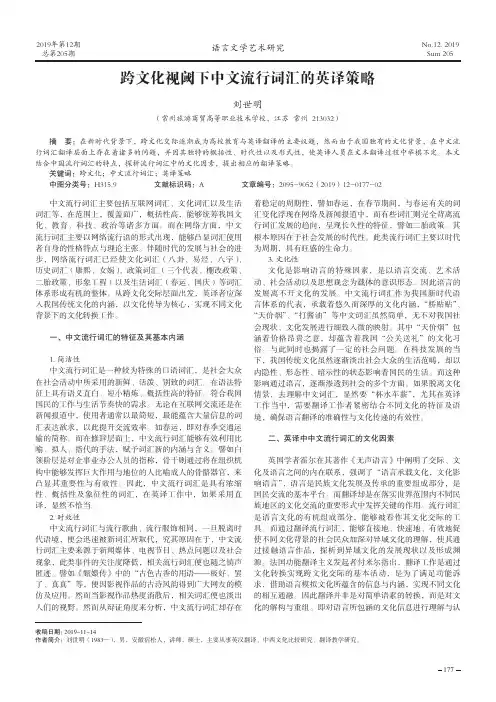
177语言文学艺术研究2019年第12期总第205期No.12. 2019Sum 205中文流行词汇主要包括互联网词汇、文化词汇以及生活词汇等,在范围上,覆盖面广,概括性高,能够统筹我国文化、教育、科技、政治等诸多方面。
而在网络方面,中文流行词汇主要以网络流行语的形式出现,能够凸显词汇使用者自身的性格特点与理论主张。
伴随时代的发展与社会的进步,网络流行词汇已经使文化词汇(八卦、易经、八字)、历史词汇(康熙、女娲)、政策词汇(三个代表、棚改政策、二胎政策、形象工程)以及生活词汇(春运、国庆)等词汇体系形成有机的整体。
从跨文化交际层面出发,英译者应深入我国传统文化的内涵,以文化传导为核心,实现不同文化背景下的文化转换工作。
一、中文流行词汇的特征及其基本内涵1.简洁性中文流行词汇是一种较为特殊的口语词汇,是社会大众在社会活动中所采用的新鲜、活泼、别致的词汇。
在语法特征上具有语义直白、短小精炼、概括性高的特征。
符合我国国民的工作与生活节奏快的需求。
无论在互联网交流还是在新闻报道中,使用者通常以最简短,最能蕴含大量信息的词汇表达欲求,以此提升交流效率。
如春运,即对春季交通运输的简称。
而在修辞层面上,中文流行词汇能够有效利用比喻、拟人、指代的手法,赋予词汇新的内涵与含义。
譬如白领阶层是对企事业办公人员的指称,骨干则通过将在组织机构中能够发挥巨大作用与地位的人比喻成人的骨骼器官,来凸显其重要性与有效性。
因此,中文流行词汇是具有浓缩性、概括性及象征性的词汇,在英译工作中,如果采用直译,显然不恰当。
2.时效性中文流行词汇与流行歌曲、流行服饰相同,一旦脱离时代语境,便会迅速被新词汇所取代,究其原因在于,中文流行词汇主要来源于新闻媒体、电视节目、热点问题以及社会现象,此类事件的关注度降低,相关流行词汇便也随之销声匿迹。
譬如《甄嬛传》中的“古色古香的用语——极好、罢了、真真”等,便因影视作品的古诗风韵得到广大网友的模仿及应用。
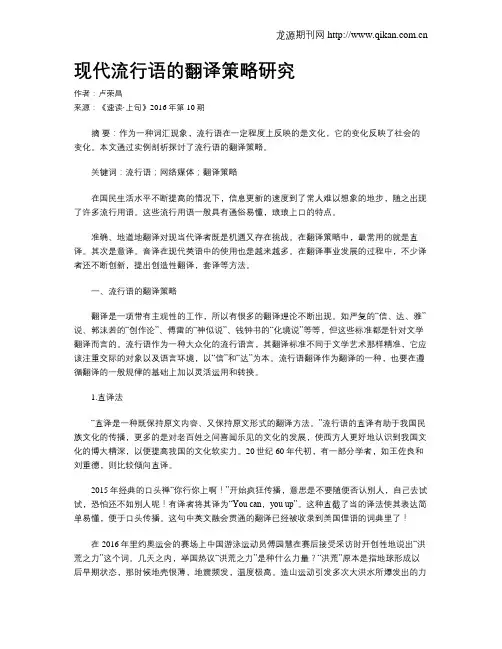
现代流行语的翻译策略研究作者:卢荣昌来源:《速读·上旬》2016年第10期摘要:作为一种词汇现象,流行语在一定程度上反映的是文化,它的变化反映了社会的变化。
本文通过实例剖析探讨了流行语的翻译策略。
关键词:流行语;网络媒体;翻译策略在国民生活水平不断提高的情况下,信息更新的速度到了常人难以想象的地步,随之出现了许多流行用语。
这些流行用语一般具有通俗易懂,琅琅上口的特点。
准确、地道地翻译对现当代译者既是机遇又存在挑战。
在翻译策略中,最常用的就是直译。
其次是意译。
音译在现代英语中的使用也是越来越多。
在翻译事业发展的过程中,不少译者还不断创新,提出创造性翻译,套译等方法。
一、流行语的翻译策略翻译是一项带有主观性的工作,所以有很多的翻译理论不断出现。
如严复的“信、达、雅”说、郭沫若的“创作论”、傅雷的“神似说”、钱钟书的“化境说”等等,但这些标准都是针对文学翻译而言的。
流行语作为一种大众化的流行语言,其翻译标准不同于文学艺术那样精准,它应该注重交际的对象以及语言环境,以“信”和“达”为本。
流行语翻译作为翻译的一种,也要在遵循翻译的一般规律的基础上加以灵活运用和转换。
1.直译法“直译是一种既保持原文内容、又保持原文形式的翻译方法。
”流行语的直译有助于我国民族文化的传播,更多的是对老百姓之间喜闻乐见的文化的发展,使西方人更好地认识到我国文化的博大精深,以便提高我国的文化软实力。
20世纪60年代初,有一部分学者,如王佐良和刘重德,则比较倾向直译。
2015年经典的口头禅“你行你上啊!”开始疯狂传播,意思是不要随便否认别人,自己去试试,恐怕还不如别人呢!有译者将其译为“You can,you up”。
这种直截了当的译法使其表达简单易懂,便于口头传播。
这句中英文融会贯通的翻译已经被收录到美国俚语的词典里了!在2016年里约奥运会的赛场上中国游泳运动员傅园慧在赛后接受采访时开创性地说出“洪荒之力”这个词。
几天之内,举国热议“洪荒之力”是种什么力量?“洪荒”原本是指地球形成以后早期状态,那时候地壳很薄,地震频发,温度极高。
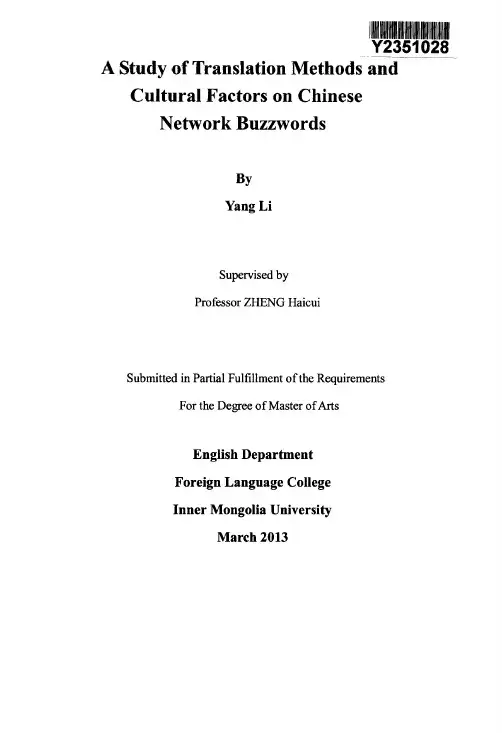
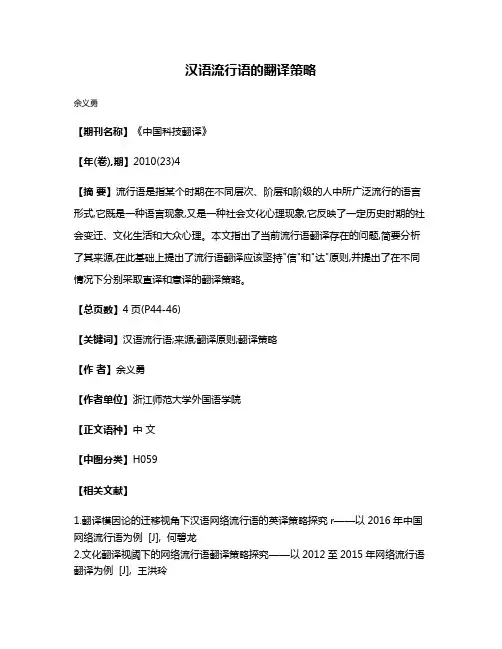
汉语流行语的翻译策略
余义勇
【期刊名称】《中国科技翻译》
【年(卷),期】2010(23)4
【摘要】流行语是指某个时期在不同层次、阶层和阶级的人中所广泛流行的语言形式,它既是一种语言现象,又是一种社会文化心理现象,它反映了一定历史时期的社会变迁、文化生活和大众心理。
本文指出了当前流行语翻译存在的问题,简要分析了其来源,在此基础上提出了流行语翻译应该坚持"信"和"达"原则,并提出了在不同情况下分别采取直译和意译的翻译策略。
【总页数】4页(P44-46)
【关键词】汉语流行语;来源;翻译原则;翻译策略
【作者】余义勇
【作者单位】浙江师范大学外国语学院
【正文语种】中文
【中图分类】H059
【相关文献】
1.翻译模因论的迁移视角下汉语网络流行语的英译策略探究r——以2016年中国网络流行语为例 [J], 何碧龙
2.文化翻译视阈下的网络流行语翻译策略探究——以2012至2015年网络流行语翻译为例 [J], 王洪玲
3.生态翻译学视角下汉语网络流行语英译策略研究 [J], 周健美
4.翻译模因论视角下汉语流行语的英译策略研究 [J], 王莉
5.翻译模因论视角下汉语流行语的英译策略研究 [J], 王莉
因版权原因,仅展示原文概要,查看原文内容请购买。
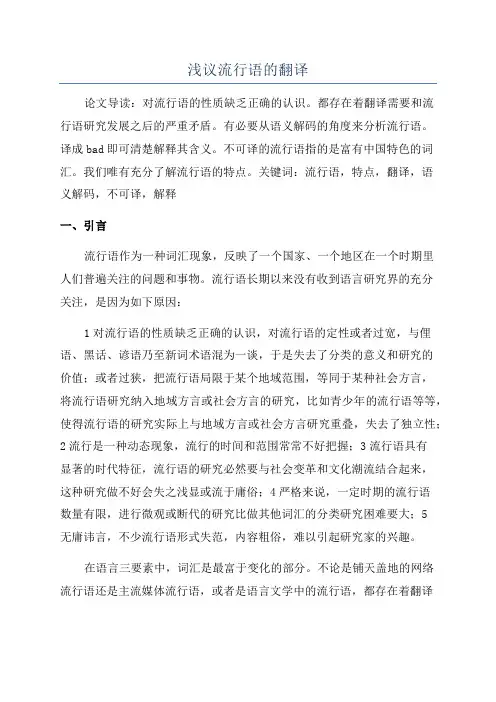
浅议流行语的翻译论文导读:对流行语的性质缺乏正确的认识。
都存在着翻译需要和流行语研究发展之后的严重矛盾。
有必要从语义解码的角度来分析流行语。
译成bad即可清楚解释其含义。
不可译的流行语指的是富有中国特色的词汇。
我们唯有充分了解流行语的特点。
关键词:流行语,特点,翻译,语义解码,不可译,解释一、引言流行语作为一种词汇现象,反映了一个国家、一个地区在一个时期里人们普遍关注的问题和事物。
流行语长期以来没有收到语言研究界的充分关注,是因为如下原因:1对流行语的性质缺乏正确的认识,对流行语的定性或者过宽,与俚语、黑话、谚语乃至新词术语混为一谈,于是失去了分类的意义和研究的价值;或者过狭,把流行语局限于某个地域范围,等同于某种社会方言,将流行语研究纳入地域方言或社会方言的研究,比如青少年的流行语等等,使得流行语的研究实际上与地域方言或社会方言研究重叠,失去了独立性;2流行是一种动态现象,流行的时间和范围常常不好把握;3流行语具有显著的时代特征,流行语的研究必然要与社会变革和文化潮流结合起来,这种研究做不好会失之浅显或流于庸俗;4严格来说,一定时期的流行语数量有限,进行微观或断代的研究比做其他词汇的分类研究困难要大;5无庸讳言,不少流行语形式失范,内容粗俗,难以引起研究家的兴趣。
在语言三要素中,词汇是最富于变化的部分。
不论是铺天盖地的网络流行语还是主流媒体流行语,或者是语言文学中的流行语,都存在着翻译需要和流行语研究发展之后的严重矛盾。
本文将就流行语的特征以及翻译方法做一些研究。
二、流行语的特点流行语是一个动态的过程,经历显现-----流行-----消失的过程。
流行语的发展前途只能有两种:一是消失,即在使用中被淘汰;二是被接纳,进入一般词汇。
因此,我们可以归纳出流行语具备的几个主要特点:1、动态性,或消亡性。
流行本身就是必将消失的过程,长期刘希的就不叫做流行而叫做主流了。
有的流行语来去匆匆,有的则持续许久,如入世、申奥等。
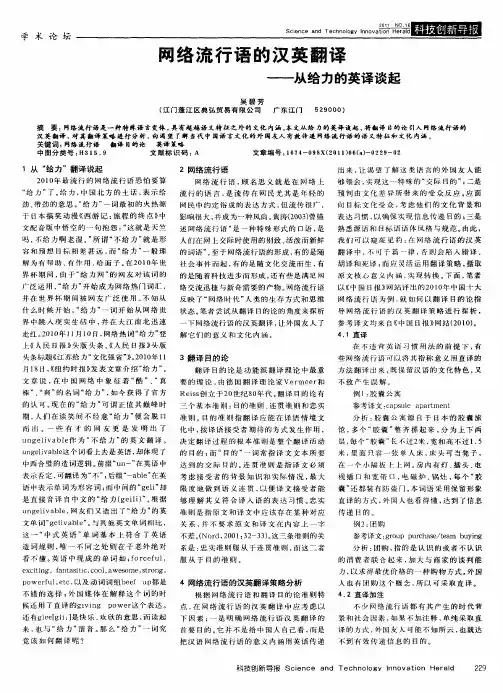
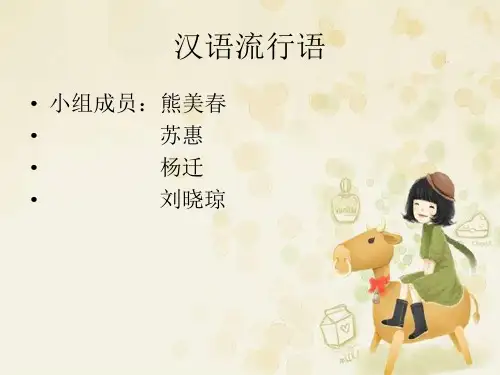
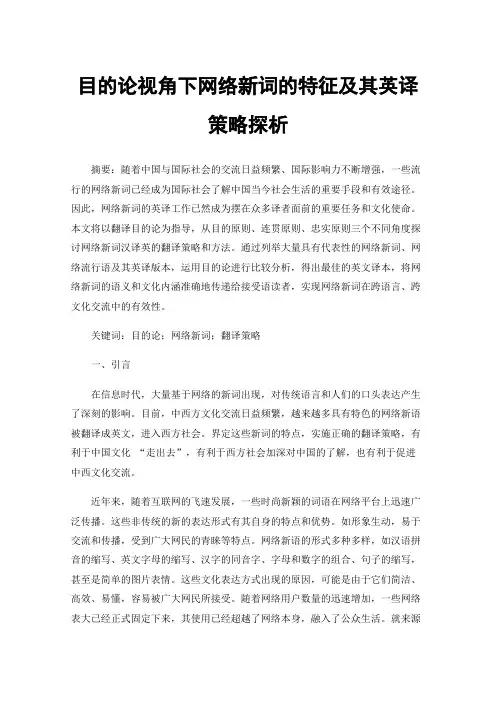
目的论视角下网络新词的特征及其英译策略探析摘要:随着中国与国际社会的交流日益频繁、国际影响力不断增强,一些流行的网络新词已经成为国际社会了解中国当今社会生活的重要手段和有效途径。
因此,网络新词的英译工作已然成为摆在众多译者面前的重要任务和文化使命。
本文将以翻译目的论为指导,从目的原则、连贯原则、忠实原则三个不同角度探讨网络新词汉译英的翻译策略和方法。
通过列举大量具有代表性的网络新词、网络流行语及其英译版本,运用目的论进行比较分析,得出最佳的英文译本,将网络新词的语义和文化内涵准确地传递给接受语读者,实现网络新词在跨语言、跨文化交流中的有效性。
关键词:目的论;网络新词;翻译策略一、引言在信息时代,大量基于网络的新词出现,对传统语言和人们的口头表达产生了深刻的影响。
目前,中西方文化交流日益频繁,越来越多具有特色的网络新语被翻译成英文,进入西方社会。
界定这些新词的特点,实施正确的翻译策略,有利于中国文化“走出去”,有利于西方社会加深对中国的了解,也有利于促进中西文化交流。
近年来,随着互联网的飞速发展,一些时尚新颖的词语在网络平台上迅速广泛传播。
这些非传统的新的表达形式有其自身的特点和优势。
如形象生动,易于交流和传播,受到广大网民的青睐等特点。
网络新语的形式多种多样,如汉语拼音的缩写、英文字母的缩写、汉字的同音字、字母和数字的组合、句子的缩写,甚至是简单的图片表情。
这些文化表达方式出现的原因,可能是由于它们简洁、高效、易懂,容易被广大网民所接受。
随着网络用户数量的迅速增加,一些网络表大已经正式固定下来,其使用已经超越了网络本身,融入了公众生活。
就来源和出处而言,网络新词的出现和传播仍然取决于各种网络平台。
各类网民、电脑或手机的使用者,都是这类词语的创造者和传播者。
最新的网络热词往往出现在网络聊天平台和各大社交网站的帖子中。
网络新词的出现可以说是持续不断,层出不穷。
它们确实已经渗透到了公众生活的方方面面。
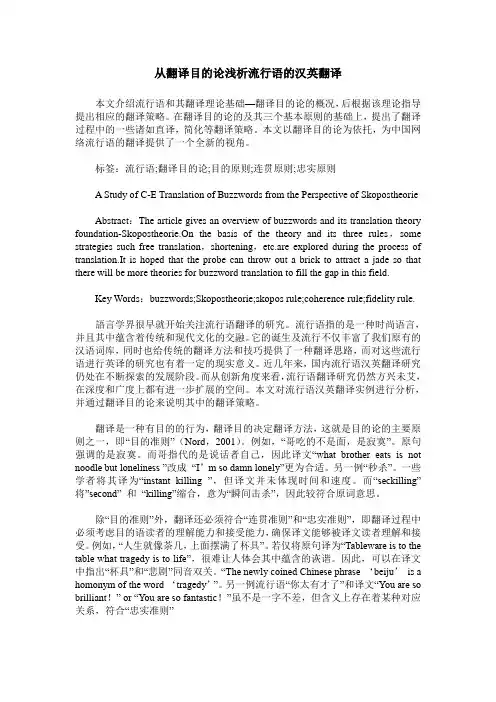
从翻译目的论浅析流行语的汉英翻译本文介绍流行语和其翻译理论基础—翻译目的论的概况,后根据该理论指导提出相应的翻译策略。
在翻译目的论的及其三个基本原则的基础上,提出了翻译过程中的一些诸如直译,简化等翻译策略。
本文以翻译目的论为依托,为中国网络流行语的翻译提供了一个全新的视角。
标签:流行语;翻译目的论;目的原则;连贯原则;忠实原则A Study of C-E Translation of Buzzwords from the Perspective of SkopostheorieAbstract:The article gives an overview of buzzwords and its translation theory foundation-Skopostheorie.On the basis of the theory and its three rules,some strategies such free translation,shortening,etc.are explored during the process of translation.It is hoped that the probe can throw out a brick to attract a jade so that there will be more theories for buzzword translation to fill the gap in this field.Key Words:buzzwords;Skopostheorie;skopos rule;coherence rule;fidelity rule.語言学界很早就开始关注流行语翻译的研究。
流行语指的是一种时尚语言,并且其中蕴含着传统和现代文化的交融。
它的诞生及流行不仅丰富了我们原有的汉语词库,同时也给传统的翻译方法和技巧提供了一种翻译思路,而对这些流行语进行英译的研究也有着一定的现实意义。
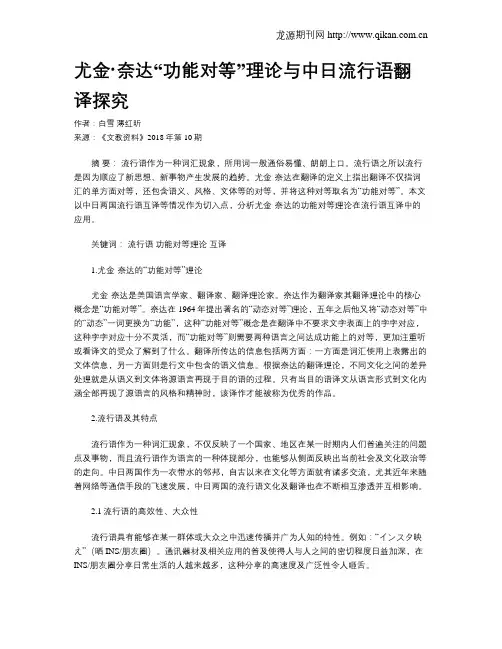
尤金·奈达“功能对等”理论与中日流行语翻译探究作者:白雪薄红昕来源:《文教资料》2018年第10期摘要:流行语作为一种词汇现象,所用词一般通俗易懂、朗朗上口。
流行语之所以流行是因为顺应了新思想、新事物产生发展的趋势。
尤金·奈达在翻译的定义上指出翻译不仅指词汇的单方面对等,还包含语义、风格、文体等的对等,并将这种对等取名为“功能对等”。
本文以中日两国流行语互译等情况作为切入点,分析尤金·奈达的功能对等理论在流行语互译中的应用。
关键词:流行语功能对等理论互译1.尤金·奈达的“功能对等”理论尤金·奈达是美国语言学家、翻译家、翻译理论家。
奈达作为翻译家其翻译理论中的核心概念是“功能对等”。
奈达在1964年提出著名的“动态对等”理论,五年之后他又将“动态对等”中的“动态”一词更换为“功能”,这种“功能对等”概念是在翻译中不要求文字表面上的字字对应,这种字字对应十分不灵活,而“功能对等”则需要两种语言之间达成功能上的对等,更加注重听或看译文的受众了解到了什么。
翻译所传达的信息包括两方面:一方面是词汇使用上表露出的文体信息,另一方面则是行文中包含的语义信息。
根据奈达的翻译理论,不同文化之间的差异处理就是从语义到文体将源语言再现于目的语的过程。
只有当目的语译文从语言形式到文化内涵全部再现了源语言的风格和精神时,该译作才能被称为优秀的作品。
2.流行语及其特点流行语作为一种词汇现象,不仅反映了一个国家、地区在某一时期内人们普遍关注的问题点及事物,而且流行语作为语言的一种体现部分,也能够从侧面反映出当前社会及文化政治等的走向。
中日两国作为一衣带水的邻邦,自古以来在文化等方面就有诸多交流,尤其近年来随着网络等通信手段的飞速发展,中日两国的流行语文化及翻译也在不断相互渗透并互相影响。
2.1流行语的高效性、大众性流行语具有能够在某一群体或大众之中迅速传播并广为人知的特性。
例如:“インスタ映え”(晒INS/朋友圈)。
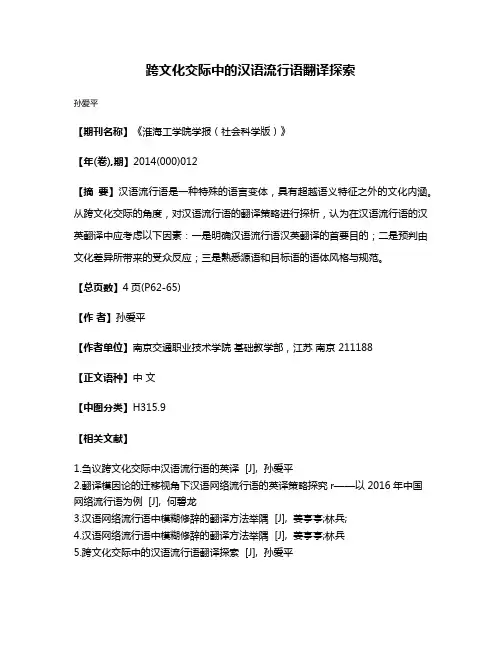
跨文化交际中的汉语流行语翻译探索
孙爱平
【期刊名称】《淮海工学院学报(社会科学版)》
【年(卷),期】2014(000)012
【摘要】汉语流行语是一种特殊的语言变体,具有超越语义特征之外的文化内涵。
从跨文化交际的角度,对汉语流行语的翻译策略进行探析,认为在汉语流行语的汉英翻译中应考虑以下因素:一是明确汉语流行语汉英翻译的首要目的;二是预判由文化差异所带来的受众反应;三是熟悉源语和目标语的语体风格与规范。
【总页数】4页(P62-65)
【作者】孙爱平
【作者单位】南京交通职业技术学院基础教学部,江苏南京 211188
【正文语种】中文
【中图分类】H315.9
【相关文献】
1.刍议跨文化交际中汉语流行语的英译 [J], 孙爱平
2.翻译模因论的迁移视角下汉语网络流行语的英译策略探究r——以2016年中国网络流行语为例 [J], 何碧龙
3.汉语网络流行语中模糊修辞的翻译方法举隅 [J], 姜亭亭;林兵;
4.汉语网络流行语中模糊修辞的翻译方法举隅 [J], 姜亭亭;林兵
5.跨文化交际中的汉语流行语翻译探索 [J], 孙爱平
因版权原因,仅展示原文概要,查看原文内容请购买。
纽马克翻译理论指导下网络流行语翻译及文化差异研究随着互联网的飞速发展,网络流行语已经成为了人们日常生活中不可或缺的一部分。
网络流行语可以是一句搞笑的段子、一个有趣的表情包,亦或是一个引起共鸣的词语,它们往往能够在短时间内在网络上迅速传播,并且成为大家茶余饭后的谈资。
网络流行语往往具有极强的时效性和地域性,要想将网络流行语准确地翻译出来并让不同文化背景的人理解并不是一件容易的事情。
本文将以纽马克翻译理论为指导,探讨网络流行语的翻译及其文化差异。
纽马克翻译理论是由德国翻译学者约翰·保罗·纽马克提出的翻译理论,该理论强调翻译的目的是为了在不同的文化背景中有效地传递信息,因此在翻译过程中需要考虑到不同文化之间的差异。
在纽马克翻译理论的指导下,翻译者需要注重对源语言和目标语言的文化背景进行深入的分析和理解,从而找到最合适的翻译方式。
在研究网络流行语的翻译及文化差异时,我们也可以借鉴纽马克翻译理论的思想,以更好地探讨网络流行语在不同文化背景下的翻译和传播。
在网络流行语的翻译中,首先需要考虑的是网络流行语的特点。
网络流行语通常是由某种特定的文化、社会事件或热点话题衍生出来的一种语言现象,它们往往承载着特定的情感、态度或价值观。
由于网络流行语的产生与传播受到了多种因素的影响,因此在进行翻译时需要充分考虑到这些因素,才能够准确地传达出源语言中所蕴含的文化信息。
在这方面,纽马克翻译理论提出的“文化同构性”和“文化异构性”观点可以为网络流行语的翻译提供一定的指导。
在翻译过程中,翻译者需要充分理解源语言中所涵盖的文化信息,并根据目标语言的文化背景进行恰当的表达,以确保信息的准确传达和文化信息的有效传递。
网络流行语的翻译还需要考虑到不同文化之间的差异。
不同文化背景下的人们对于同一个事物可能会有着不同的理解和评价,因此在进行网络流行语的翻译时需要充分考虑到不同文化之间的差异。
中国和西方国家对于幽默的理解和表达方式可能会有所不同,因此在翻译网络流行语时需要充分考虑到这一点,以避免因文化差异而导致的误解和歧义。
中国网络流行语的语言特征及其英译策略胡琴【摘要】Chinese Internet Catchwords was analyzed through a flourishing period in recent years.Quite a lot of the catchwords which have reflected current social problems were even found on some authoritative media home and abroad,which demonstrate their influence on society and culture.As the extension and innovation of Chinese language,Internet catchwords bear their own unique linguistic characteristics and significance.Therefore,the adoption of diverse strategies would be more preferred during their English translation.The linguistic features of Chinese Internet catchwords and some practical translation strategies will be given in this paper.%对中国的网络流行语在近几年的发展情况进行分析,列举一些反映社会生活的,甚至出现在国内外权威报纸杂志上产生重大影响的网络流行语。
网络流行语作为汉语言的延伸和创新,有着不同于传统汉语言的独特语言特征,因此在对这些网络流行语进行英译时,根据它们的语言特点采用灵活多样的英译策略胜过采用单一的翻译方式,并在对网络流行语的语言特点的分析基础上提出一些较为可行的英译策略。
浅析网络流行语英译问题英语翻译的目的是为了准确的能够使两种语言的思想(意境)得以沟通,而随着网络流行语的不断发展,对于网络流行语的音译也成为了一个翻译中的重要问题。
本文探讨了网络流行语的音译诸多原则,并在关联翻译理论和功能对等理论下探讨网络流行语的英译方式。
随着中国互联网的不断发展,互联网为人们的沟通带来了极大的便利性。
而在语言方面,互联网也给语言形式带来了新变化。
特别是网络流行语,成为了影响社会文化的一个重要形式。
那么在翻译过程中,如何能够将网络流行语准确的表达,并向外国友人传递其中的思想本质呢?本文将就这个问题进行探讨。
一、网络流行语的特点从语言全民性的角度来看,有些网络流行语体现了汉语普通话里的谐音现象。
网络社会是一个巨大的统一的语言社群。
只有使用普通话才不会引起交际障碍。
有些网络流行语甚至直接利用普通话中相谐音的词汇。
这种故意改变“能指”与“所指”对应关系的方式,既生动形象又不乏力度,最重要的是这种谐音所有人都听得懂,这也是它能够快速传播和流行的基本条件,反映了语言的全民性。
二、现阶段网络流行语英译常犯错误目前对网络流行语的翻译存在很多问题,主要类型整理如下:(一)译者在翻译过程中出现语法错误例如“搞定”一词,很多地方出现“work it ”这样的英译,但在英文中,后面还应该加一个介词,“work it out”才是正确完整的。
再如,“秒杀”如果画蛇添足译为“instantly kill”就出现了语法错误,正确的翻译应该是“instant kill”,因为在英语中名词可以修饰动词,表示程度,符合语意和语法规定。
(二)字面翻译有些译法是直接将词语中的每个字都刻板地翻译过来,完全没有办法领会该词的意义。
例如:把“驴友”死翻为“donkey friend”;“黄牛”则译成“yellow cattle”;“菜鸟”单纯的字面翻译有“vegetable bird”;“红榜”被翻译成“red board”;“走光”则直接翻译为“go light”。
82作者简介:洪洁,女,南京邮电大学外国语学院副教授,文学博士。
功能对等视角下的汉语流行语日译研究洪 洁(南京邮电大学 外国语学院,江苏 南京 210023)摘 要:考察近三年来汉语流行语的语言特征与社会特征,对比分析《人民网(日文版)》《人民中国》《中国网(日本版)》对流行语的不同译法。
在这一基础上,以“功能对等”理论为指导,挖掘适用于不同类别流行语的日译策略。
汉语流行语的日译策略包括直译、直译+注释、意译、归化、回译五种。
直译法适用于政治、科技、经济领域的流行语。
直译+注释法和意译法适用于娱乐与社会生活领域一些具有丰富内涵的流行语。
归化译法适用于目的语中有相同指示对象的流行语。
回译法适用于源于外来词汇的流行语。
关键词:功能对等;流行语;日译;策略2021年第1期总第703期MODERN CHINESENo.1General No.703现代语文一、引言语言是社会生活的符号,它犹如一面镜子,记录了历史发展的变化轨迹。
流行语作为语言的一部分,折射出当代社会生活的方方面面。
不过,汉语流行语往往具有某一社会背景下的特定含义,很难从汉日词典中找到现成的译词。
与此同时,流行语的翻译工作尚未形成统一的理论体系,译词缺乏统一性,即便是相同的流行语,不同媒体有各自不同的译法,误译、硬译等现象屡见不鲜。
可以说,蕴含中国传统文化、展示中国时代风貌的流行语,已经成为中国当代文化的一部分,将汉语流行语翻译成地道的日语,既可以更好地推进跨文化交流,也可以推动中华文化“走出去”,从而提高国家文化软实力。
有关汉语流行语的外译研究,已有不少学者进行了有益的尝试,其中以流行语的英译研究为主。
邱大平结合《中国日报》“流行新语”栏目提供的流行词汇英译,指出了其中存在的问题,剖析了问题产生的原因,并给出了相关词语可行的英文翻译,提出了翻译时的注意事项[1]。
季红琴、董滋指出,在对汉语网络流行语进行英译时,应坚持“语体相当”和“适应性选择”的翻译原则[2]。
关于汉语流行语特点及翻译策略的探究 摘 要 流行语是指在一定社会时期广泛流传,并且能够反映当时的社会文化、风土 人情的语言。人们通过它了解一个国家的社会变迁。同样地,汉语流行语也可以帮助外国读者更好地了解中国的社会风貌和最新发展。随着中外交流的日趋频繁,汉语流行语英译的实践与理论研究越发显得重要。然而由于汉语流行语英译的无先例可循加之理论研究的滞后,汉语流行语英译中还存在不少问题。为了提高汉语流行语的翻译质量,本文在翻译理论与实践的基础上,提出了切实可行的汉语流行语的翻译原则与方法。第一章介绍了翻译与文化之间的紧密关系以及汉语流行语的相关知识。第二章阐述汉语流行语的定义,并在此基础上归纳出汉语流行语的特点。第三章综述了翻译的定义及普遍原则。第四章在第三章的基础上提出了一套切实可行的翻译策略以帮助解决汉语流行语英译中出现的问题。第五章结论部分强调了作好汉语流行语英译必备的两个条件:一是译者要掌握一定的翻译策略并根据具体情况灵活运用;二是译者要具备跨文化交际、语言学等多方面的知识,不断学习,与时俱进,提高自身素质。
关键词:流行语; 特点; 翻译; 策略
On the Features and Translation of Chinese Catchwords Abstract Catchwords refer to those widely and quickly spread words and expressions in a certain period, area or group, which, from a certain point of view, express people’s values, ideas and states of mind and reflect social phenomena. Through catchwords people can observe social changes in a country. Likewise, Chinese catchwords through which foreign audiences may have an all-round view of China’s latest situation and development, which will help them understand us better. With the increasingly frequent exchange between China and foreign countries, the theory as well as the practice of translating this kind of words is becoming more and more important. This thesis, based on the theory and practice of translation, established some translating strategies to solve problems that may arise in the translation of Chinese catchwords. Chapter 1 introduce the close relationship between translation and culture as well as some relative knowledges about Chinese catchwords. Chapter 2, on the basis of thorough analysis of Chinese catchwords’ definition, generalizes 5 features of Chinese catchwords, paving the way for the further study. Chapter 3 introduces the definition and general principles of translation .Chapter 4, on the basis of translation theory, proposes some practical strategies for the translation of Chinese catchwords into English. The conclusive chapter, chapter 5, lays stress on two points: one, translators should master a set of translation strategies and apply them flexibly; two, translators should always keep improving their overall quality to be learned people with knowledge of cross-culture communication, linguistics and so forth. Key words: Catchwords; Translation; Strategies On the Features and Translation of Chinese Catchwords
1. Introduction As a means of intercultural communication, the role of translation will be more and more important in an age of globalization, which not only embodies in economics but also in cultures as well. "Since many scholars of translation studies perceive translation as a cultural issue, it will be proper to do translation studies in the broad context of cultural studies."(王宁,2000:10 ) As translation involves the communication between two linguistically different cultures, the transference of cultural factors from one language into another should be the essence of translation. Different cultures have different ways of expressing their specific factors presented by their particular languages and that's why language is regarded as a symbol of culture. Therefore, in performing translation, it is very important to convey in a precise way the cultural connotations of the source language into the target language in addition to language elements. It has been proved by Nida's idea on translation: "For truly successful translating, biculturalism is even more important than bilingualism" (Eugene A. Nida, 2001:10). He analyzes the interrelationship between language and culture, translation and culture. He points out that translation involves not only two languages but two cultures as well. Along with the rising of China's international status, more and more foreign friends are interested in learning what China is really like and what is really happening in China. For many foreigners China is a country both exotic and modern. It has long history of culture of thousands of years and its economy has developed vigorously over the last two decades, arousing worldwide attention. Indeed, China has a glorious history of 5,000 years; China is standing up in the East; China has become a big market. Under these circumstances, how to do better Chinese-English translations and produce readable English